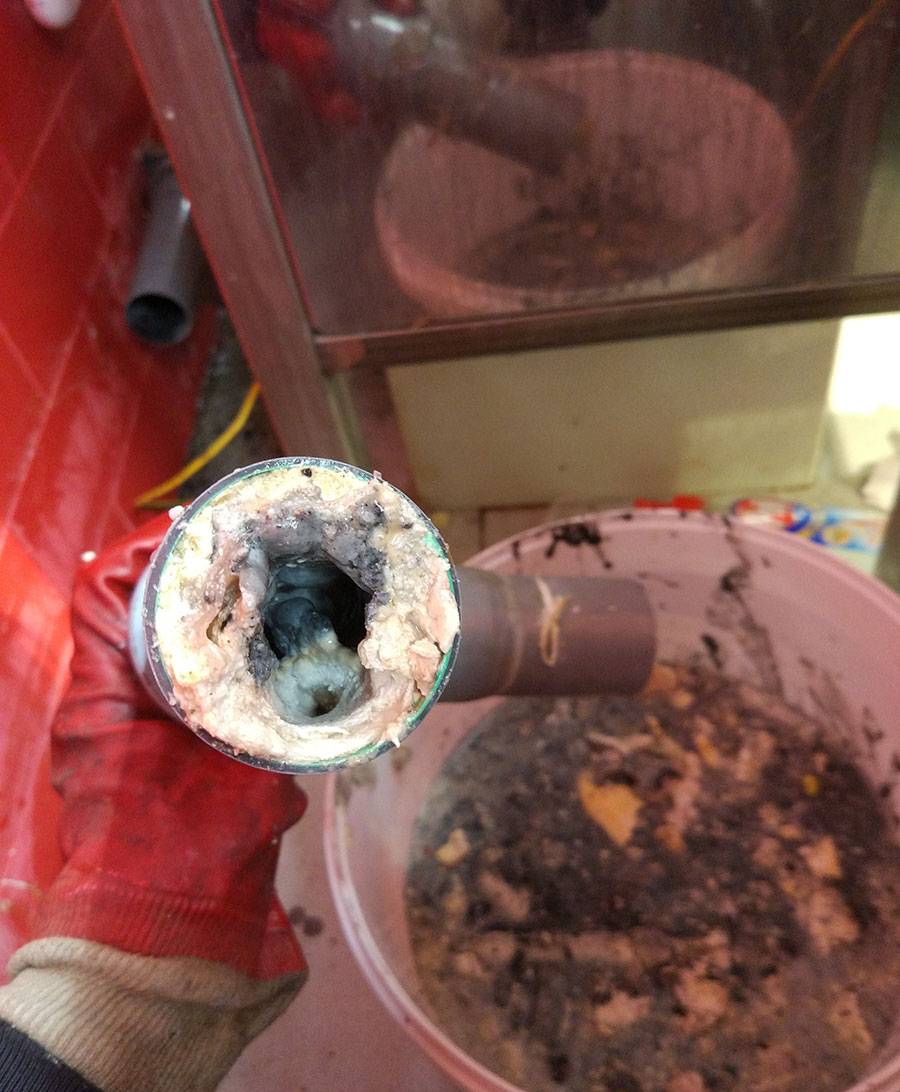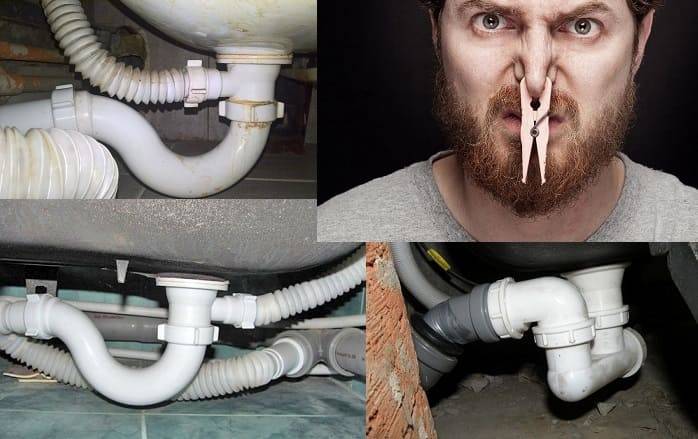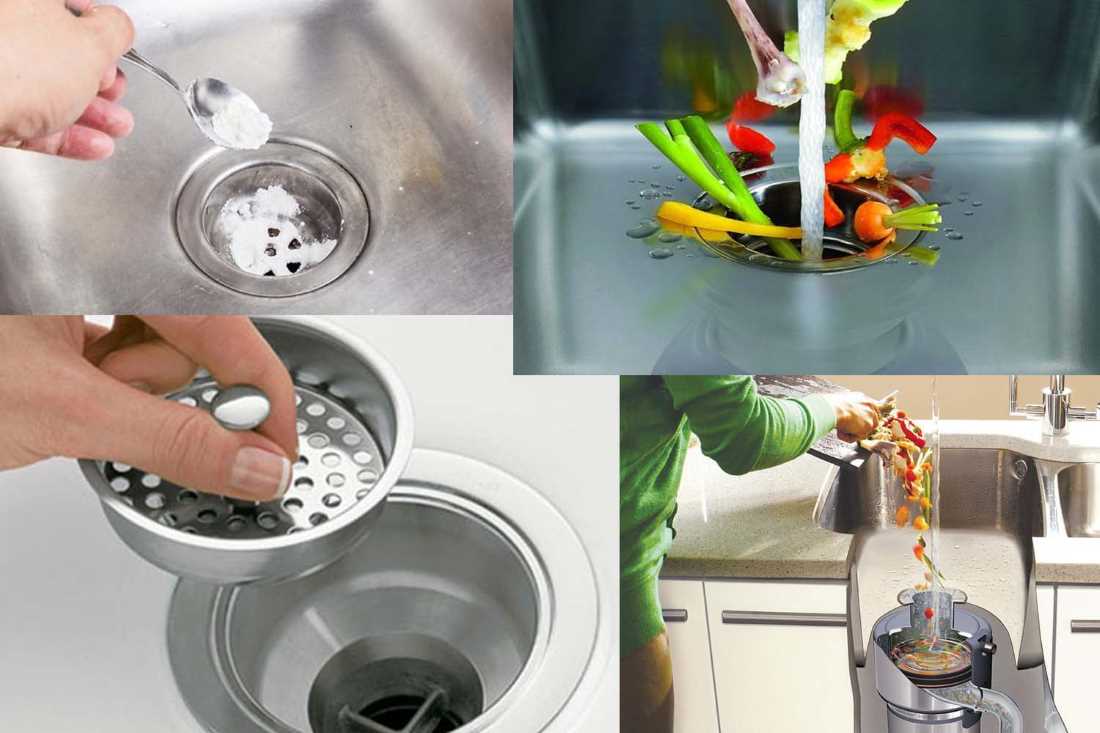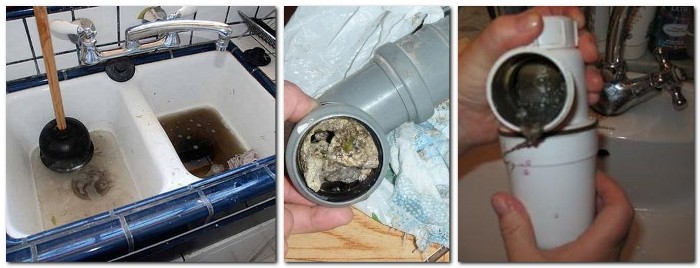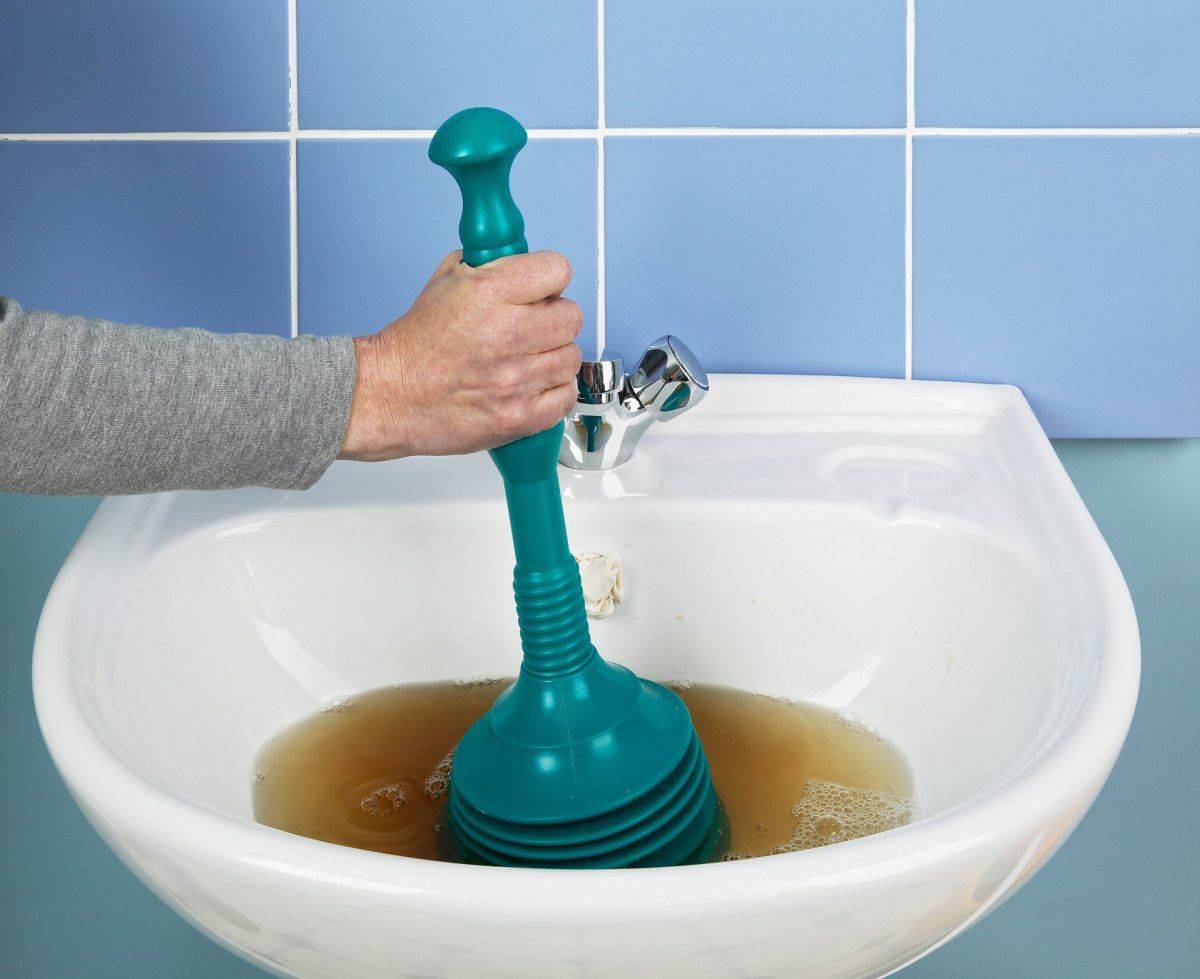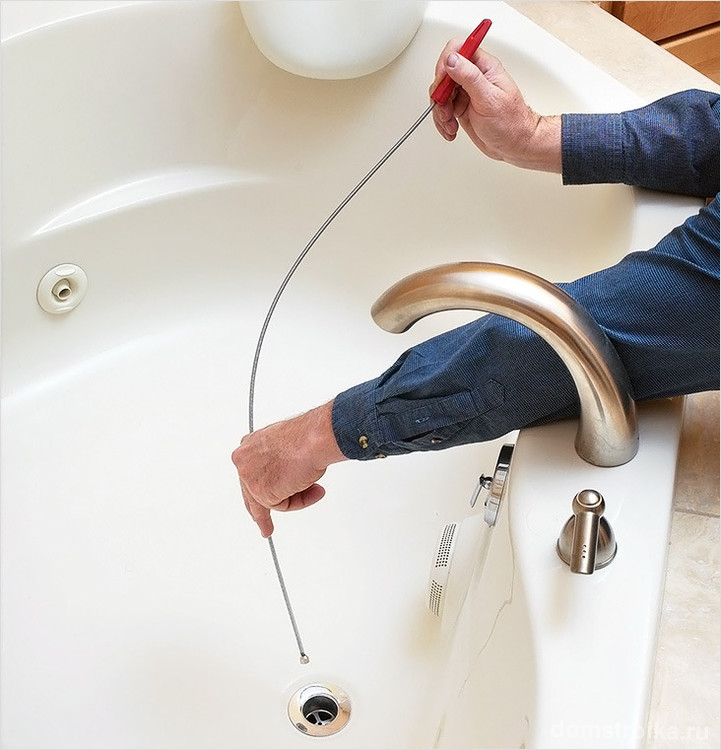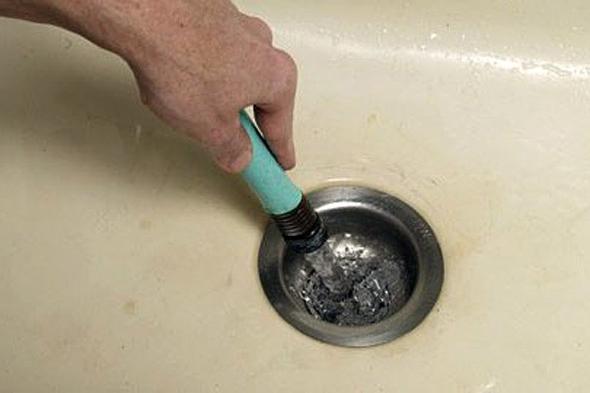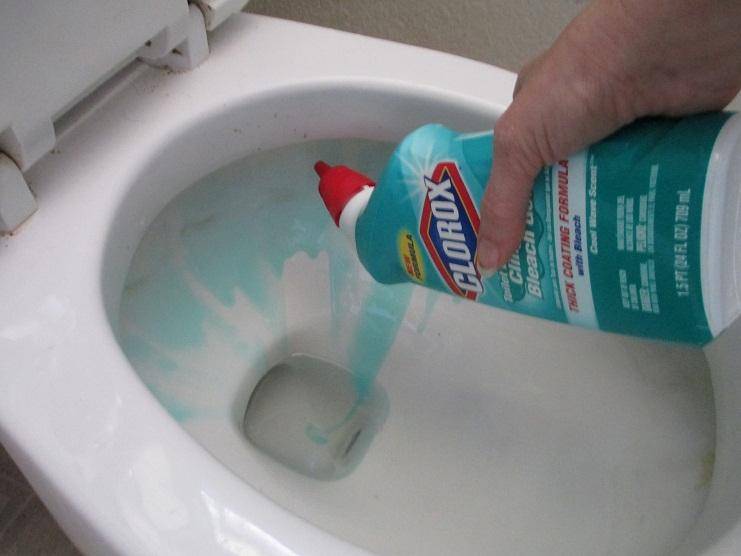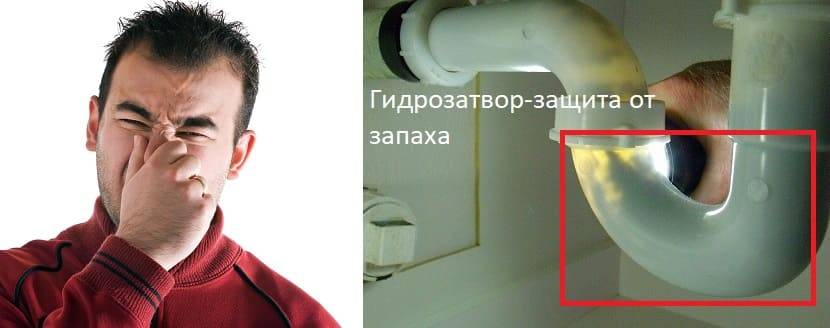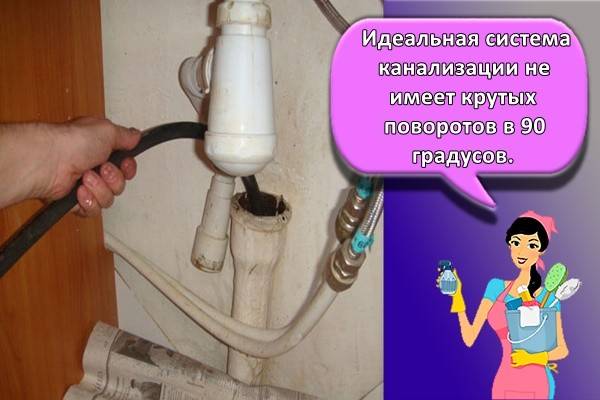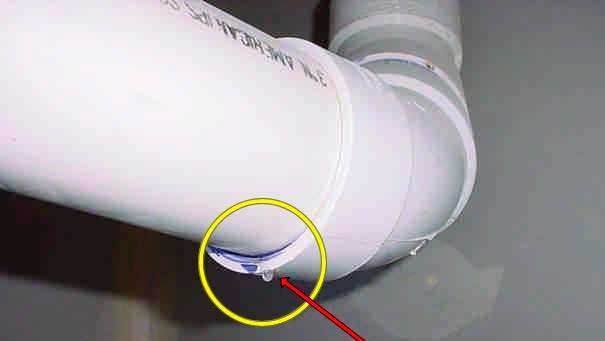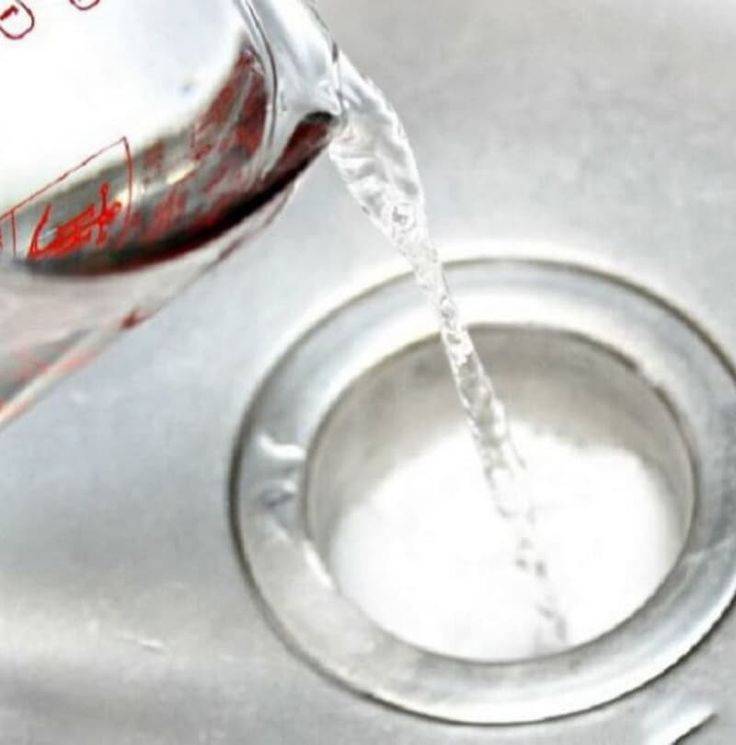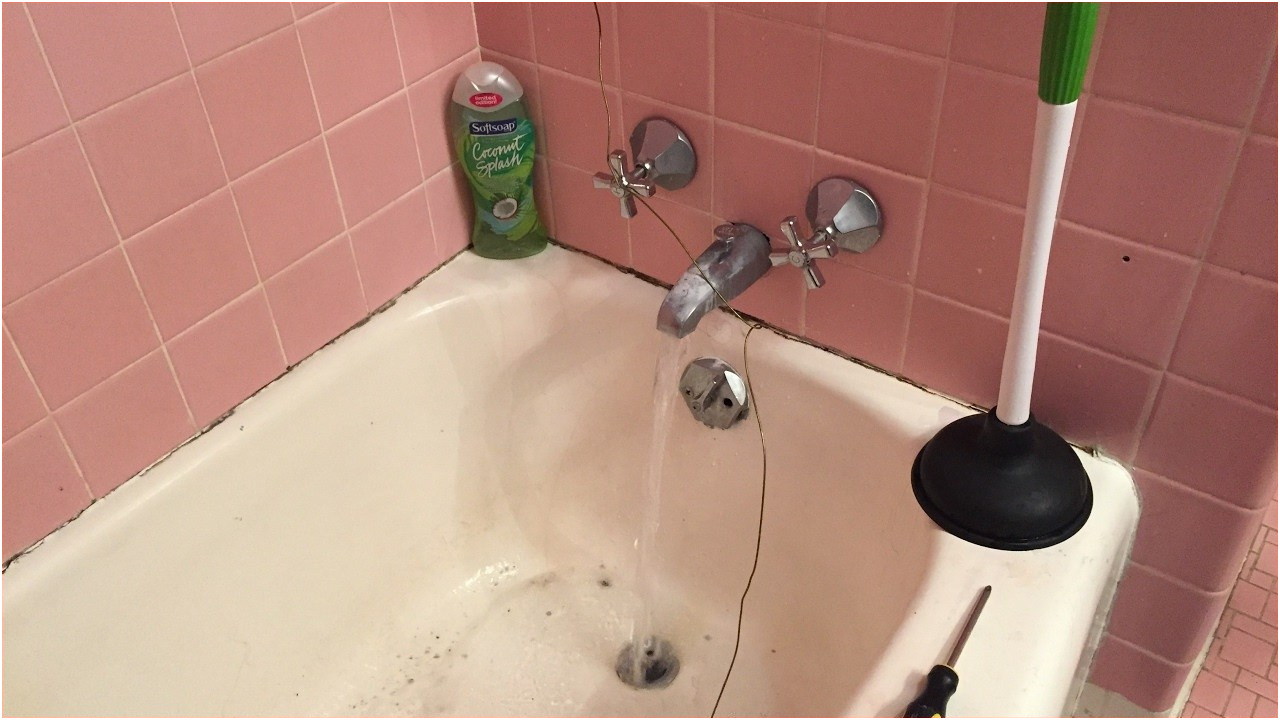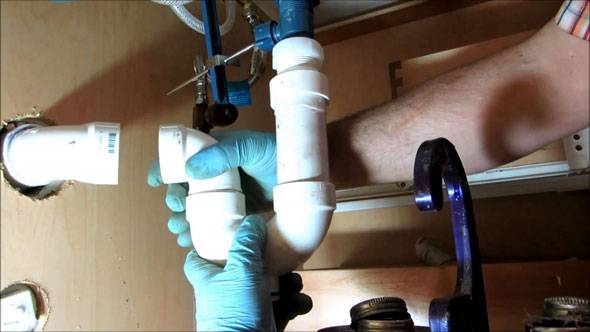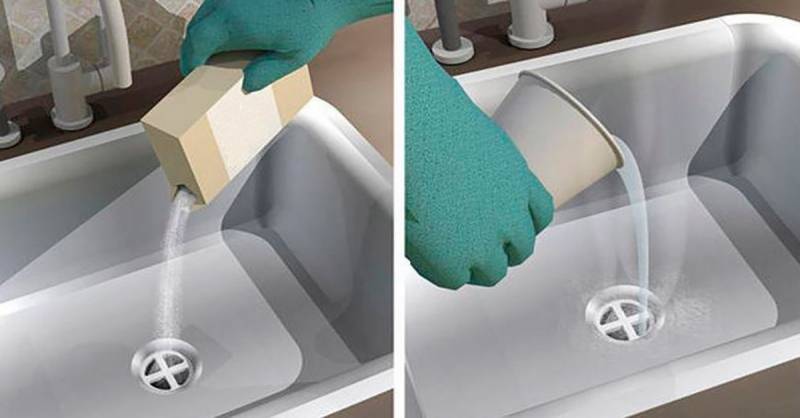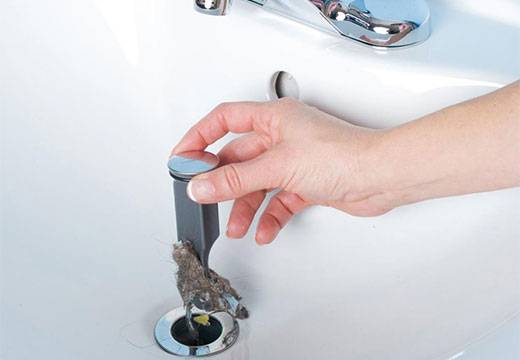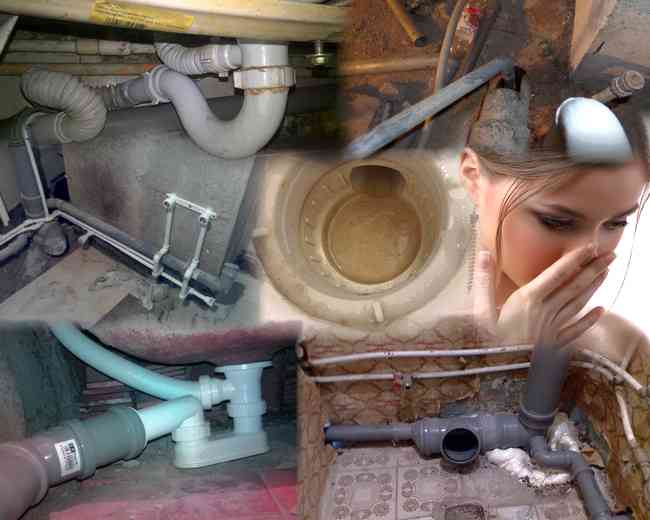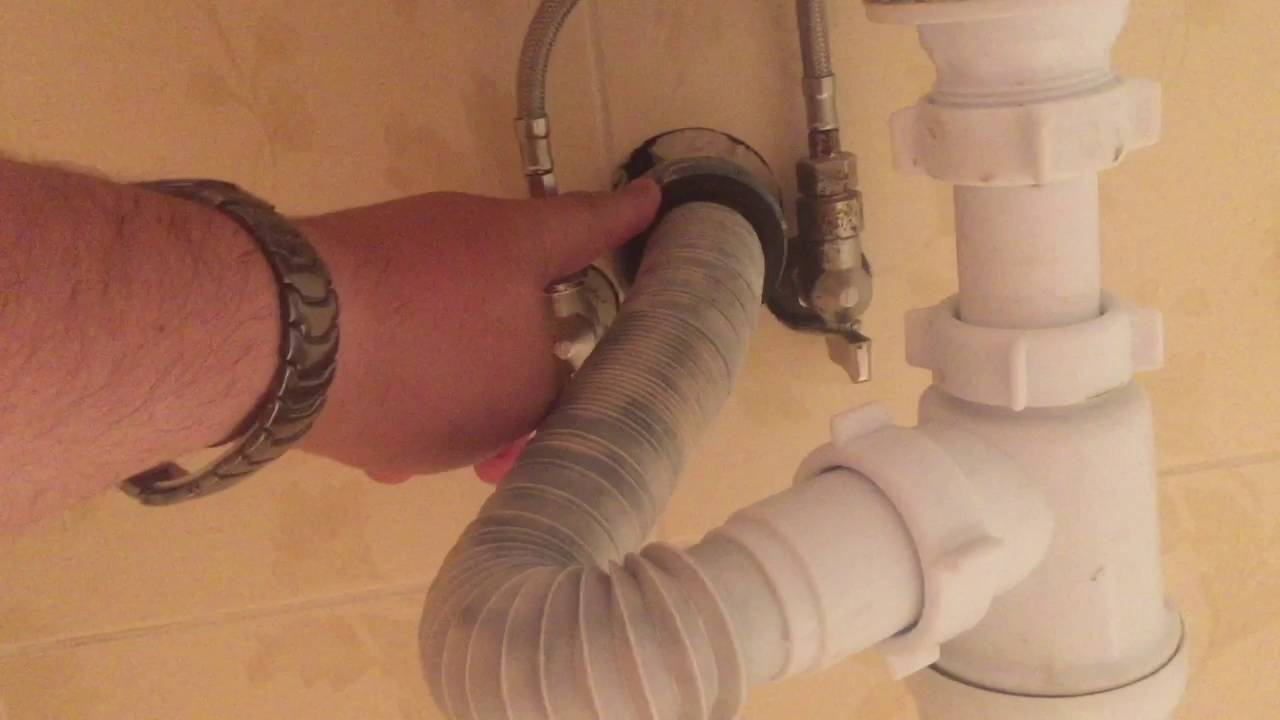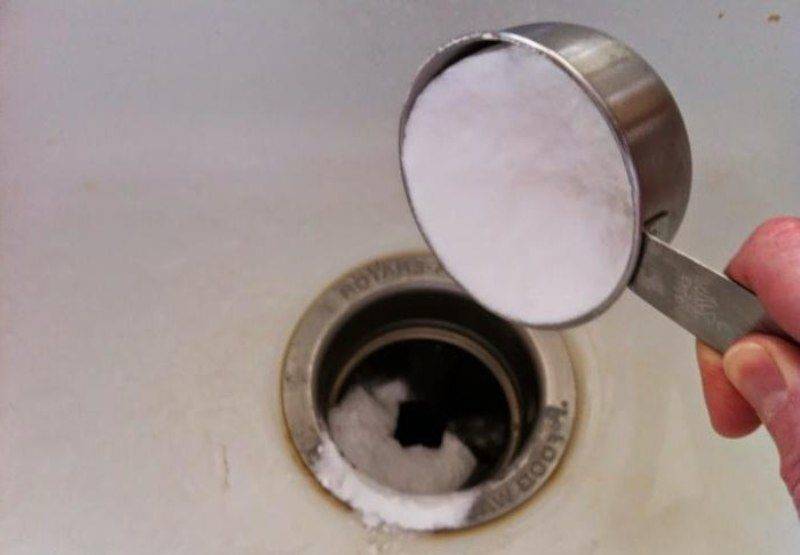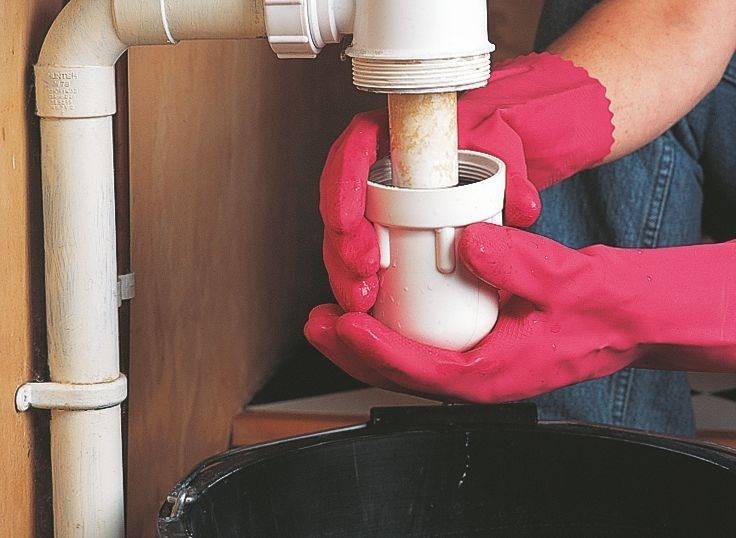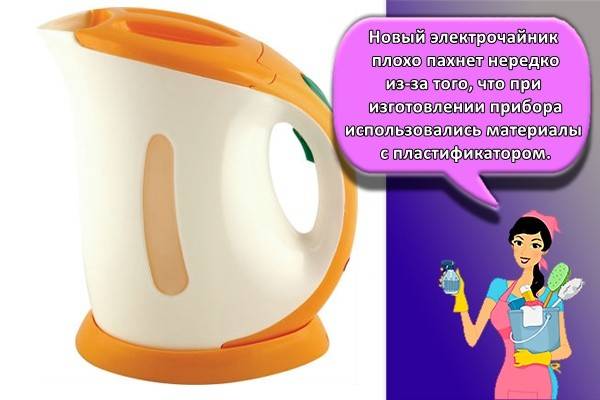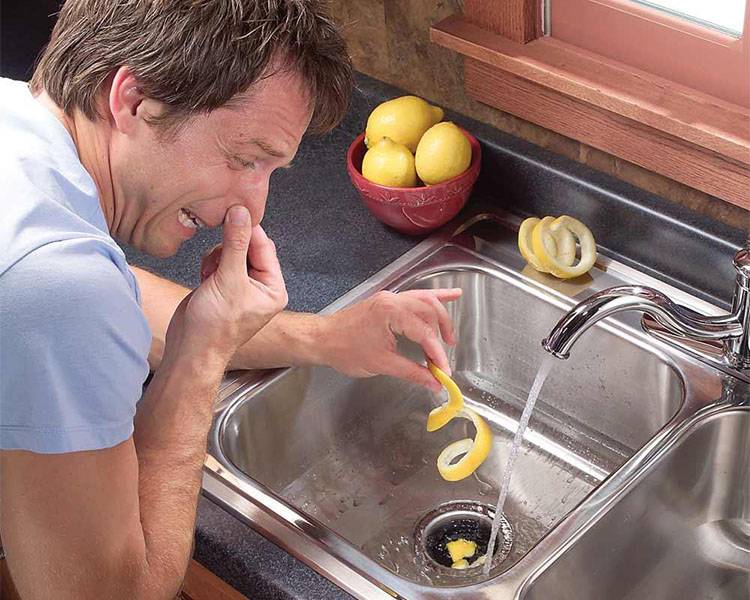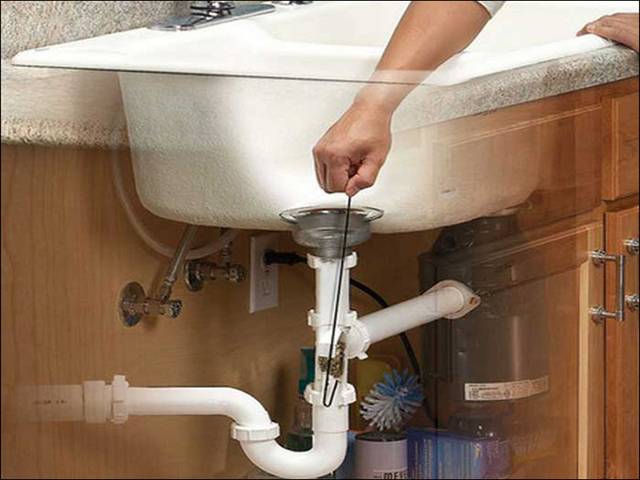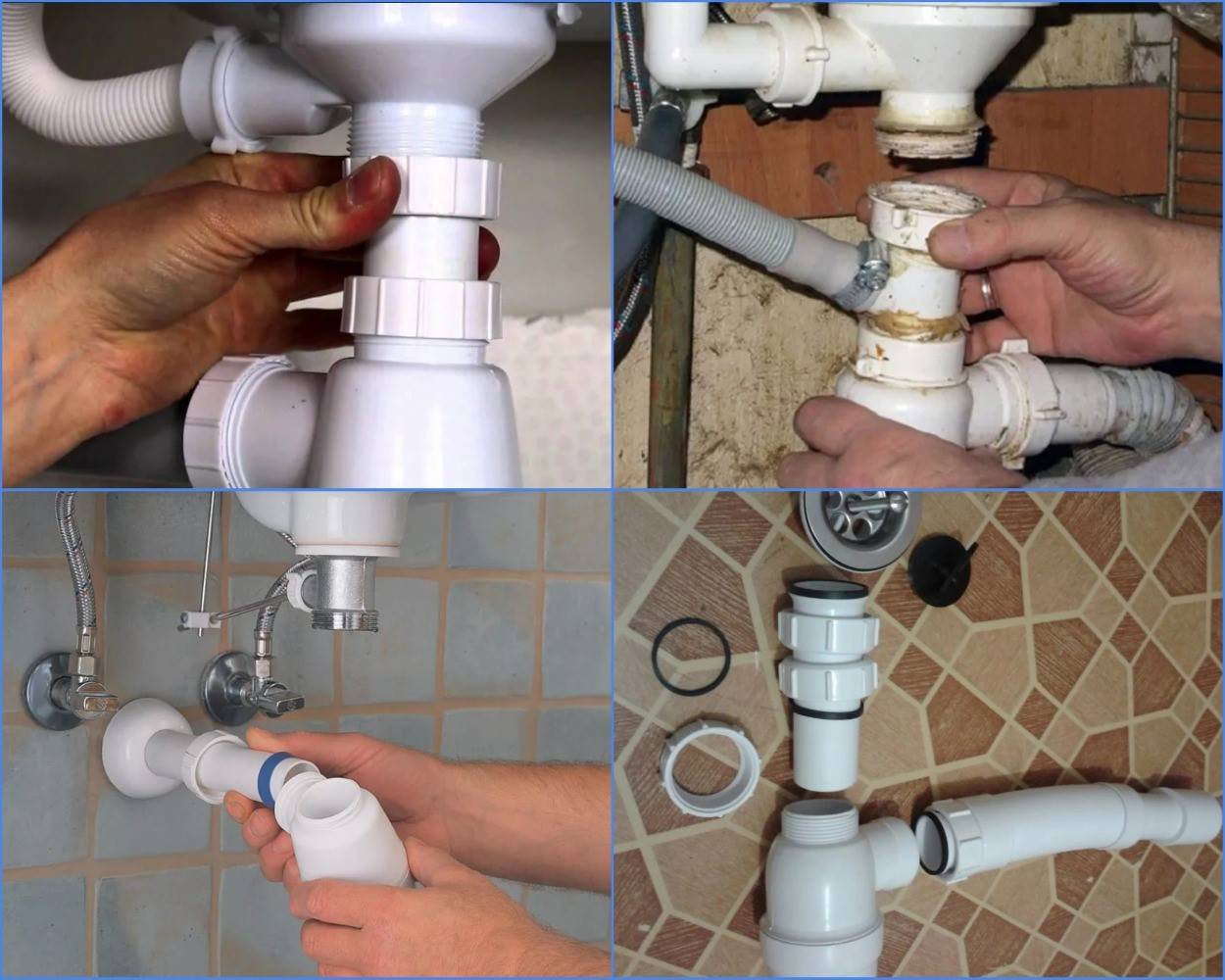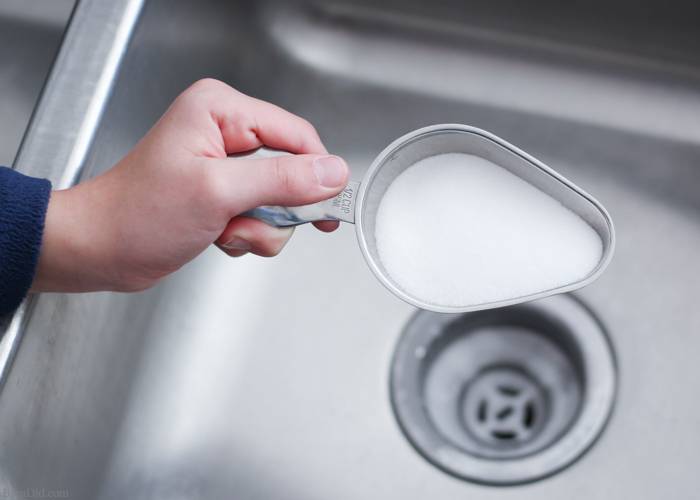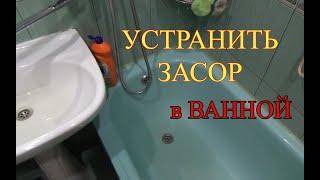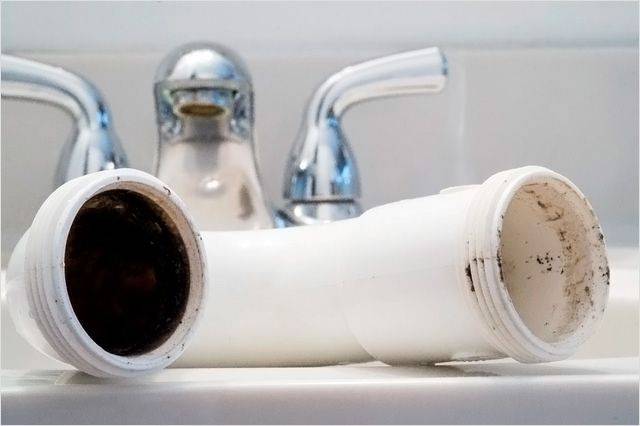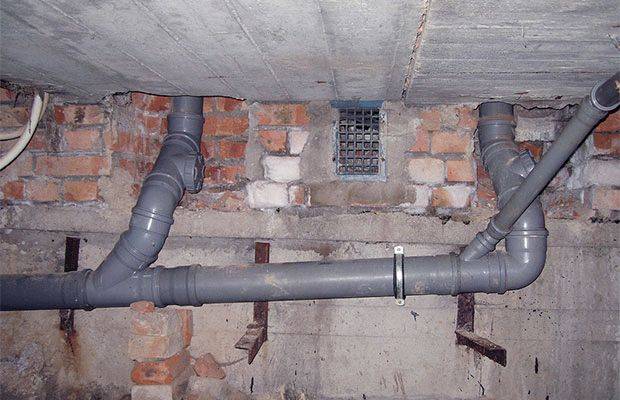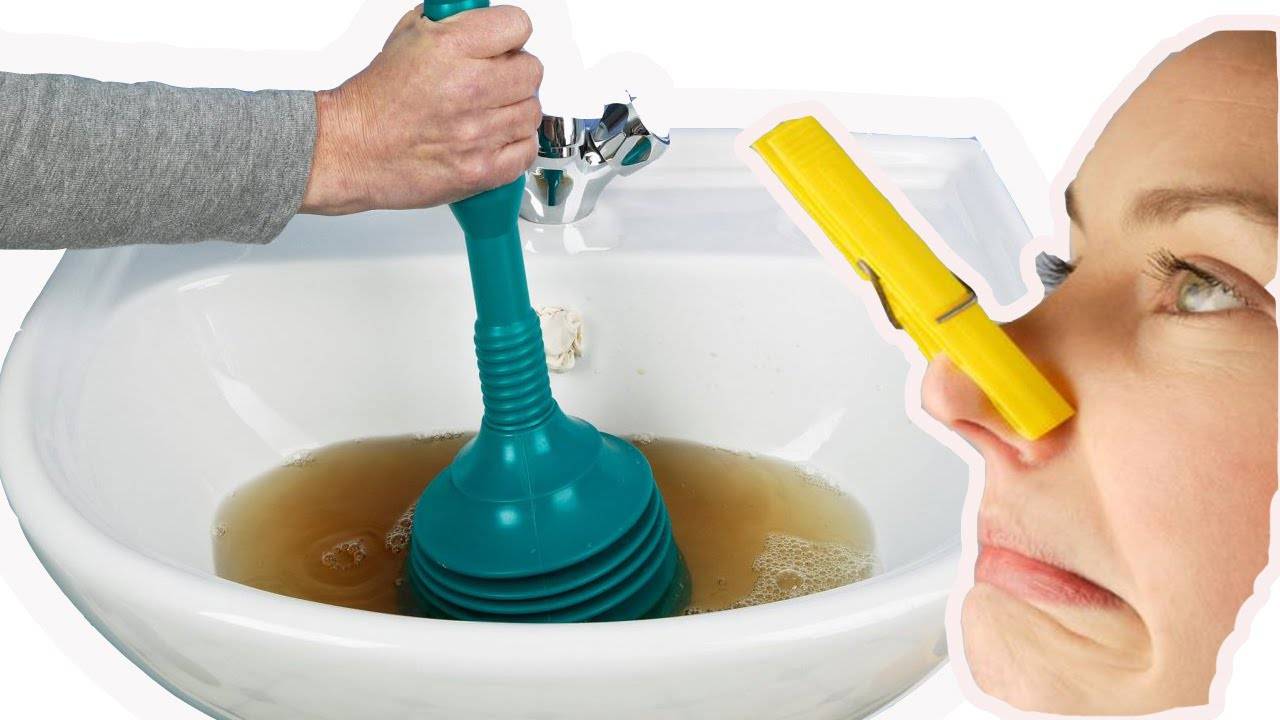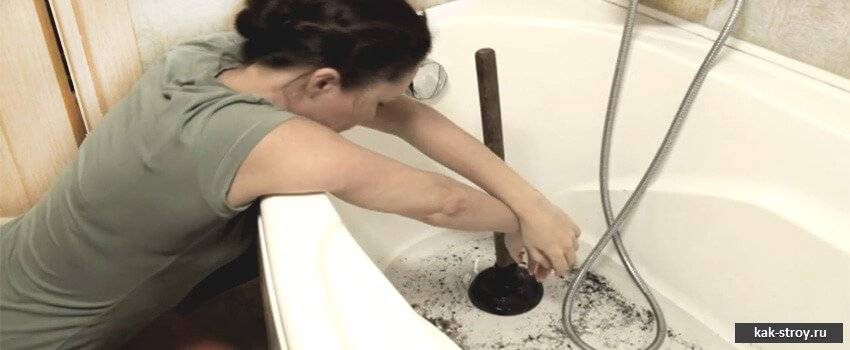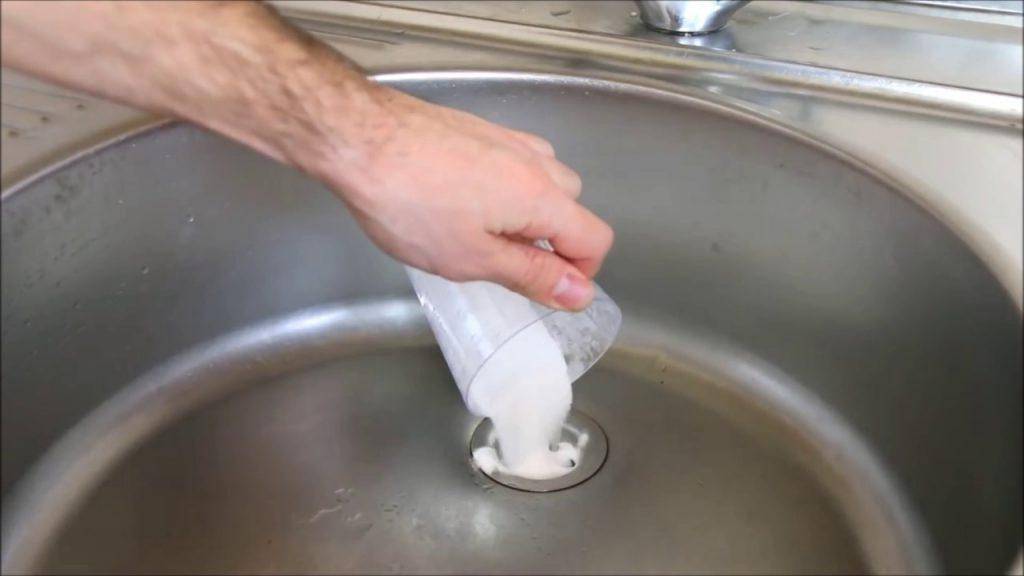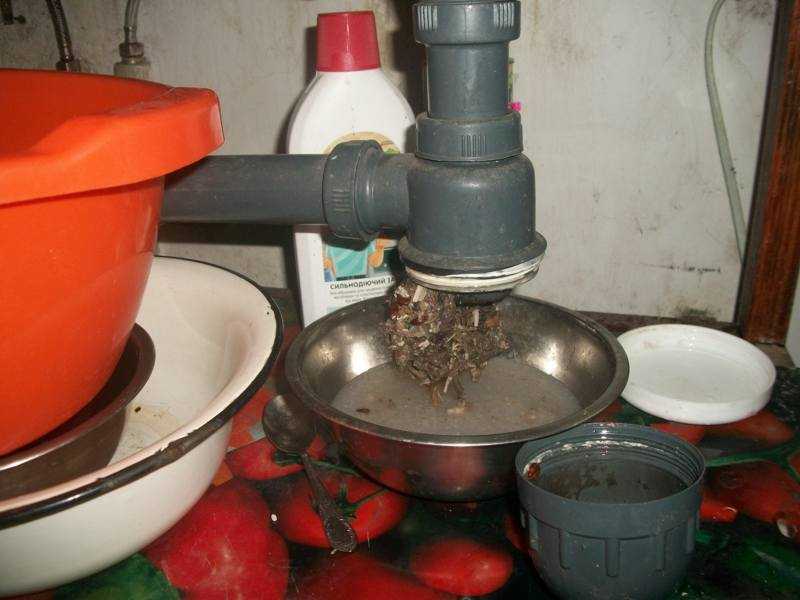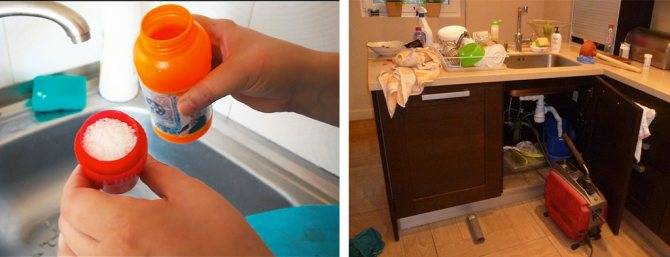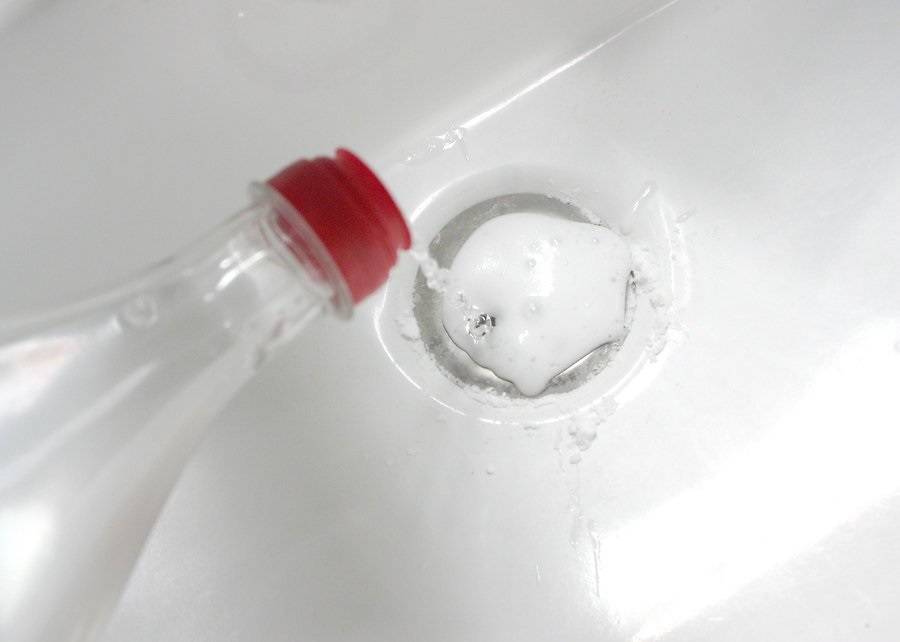Why does the sink smell
Before combating bad odor, I recommend addressing its root cause. Otherwise, the unpleasant scent will appear over and over again, and you will tire of waging an endless struggle.
Incorrect installation of the siphon or corrugation
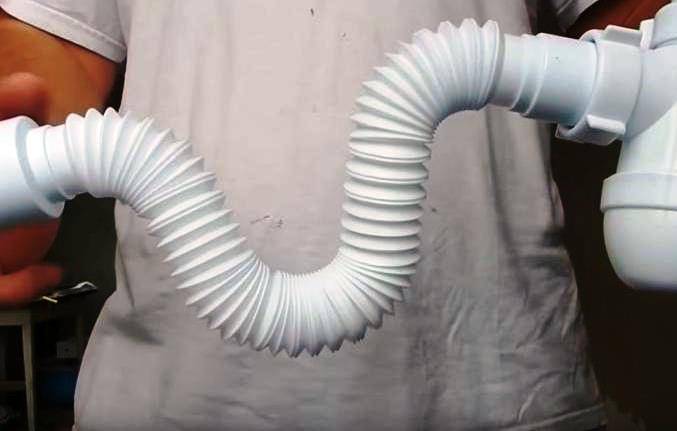
Incorrect installation fully affects the appearance of an unpleasant odor from the sink. This happens for 3 reasons:
There is no liquid in the water seal. If installed incorrectly, the plastic tube does not reach the desired liquid level mark in the flask
It is important to correctly adjust the depth of the fitting so that all the water does not go into the drain, but also does not pour back into the sink.
The liquid in the water seal has evaporated. If you do not use the sink for a long time, over time the water in the siphon will evaporate, which will cause a stench from the sewer.
To prevent this, before a long absence, pour a little vegetable oil into the drain, which will prevent the moisture from completely evaporating.
The siphon is loose or the corrugation is stretched. A similar problem will require replacement of component parts or repair of the siphon.
Siphon contamination
The curved shape of the siphon, in fact, prevents the penetration of unpleasant odors. However, if dirty water or food waste builds up on the walls of your knee, an unpleasant odor will start to emanate from the sink. This happens even if you keep your sink clean and use special drainage nets.
Stagnation
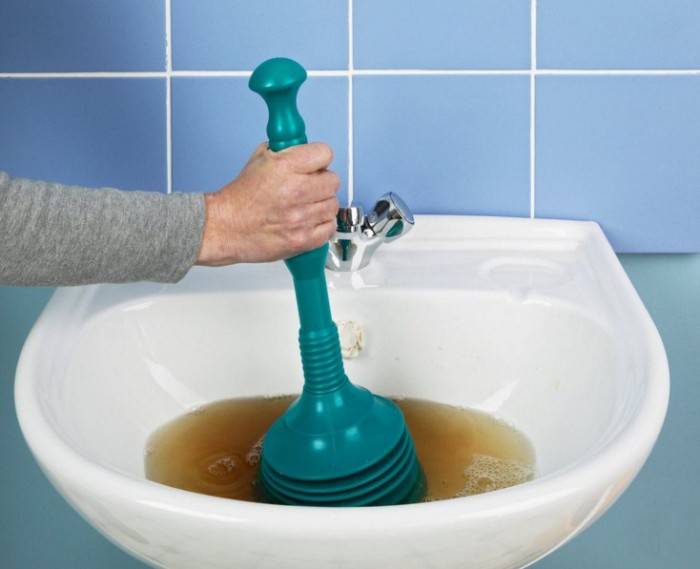
A similar reason appears with prolonged use of the siphon without hygienic cleaning. During operation, plaque accumulates on the walls, which, as it grows, narrows the drain hole. As a result, water flows out more slowly, forming stagnation in the pipe, which begins to rot, giving off an unpleasant odor. It is better to deal with such a problem with the help of professionals or by using special means.
Leakage violation
If the work on the installation of the sink and its components was not performed properly, an unpleasant odor will soon appear in the kitchen. This is due to the fact that the joints were not properly sealed. As a result, fumes from the sewer systems penetrate through the openings that were supposed to be closed. Fortunately, this problem is fairly easy to spot and not difficult to fix. Usually, water seeps through leaking joints, which is fraught with the formation of mold, so it is best to solve the problem as soon as possible.
Other reasons
Sometimes other parts of the sewer system can be the source of the odor. For example, a drain pipe cracks or air appears in a riser. Only plumbers from the management company can solve such problems.
How to find the cause or breakdown

If you begin to notice that the room smells like sewage, try to find and eliminate the cause as soon as possible.
First, check all pipes of the sewer system for breakage. If a problem is found in this place, call a plumber. If there are no problems with the pipes, check the siphon under the sink. At the same time, only an external examination is not enough. Be sure to dismantle the siphon and corrugation, and view the system from the inside. If you find a blockage or plaque - clean the siphon, and reinstall it in place, in the same position as before. If you notice a malfunction in the siphon, it is better to replace it with a new one. Otherwise, the smell will reappear.
How to mechanically remove odor from kitchen sinks
Such methods are only suitable if a blockage is the cause of the unpleasant odor.With a plunger, a plumbing cable or a country hose, you can easily eliminate the impaired permeability in the kitchen sink. In severe cases, it will be easier to disassemble and rinse the siphon if the design of the sink in the kitchen provides such an opportunity.
Ventuz
It is best to use small plungers designed specifically for dealing with blockages in kitchens and washbasins. To correct the obstruction of the pipes, you will need to place a plunger around the drain hole. Fill the sink with enough water to cover the rubber part of the structure by 2/3. Then, make several reciprocating movements with the plunger cone, without lifting its edges from the sink.
Plumbing cable
The smell of sewage caused by plaque on the inner walls of communications cannot be removed. The main purpose of using a plumbing cable is to break through mechanical blockages in the kitchen. To use the cable, you need to immerse it in the drain and turn the special handle. If a blockage is found, you can either try to push it further into the pipe, or pull it out using the reverse.
Country hose
When using a hose, remove the mesh that traps debris in the sink drain and then place the hose there. The area around it must be plugged so that water does not rise into the sink itself. Further, water is supplied under pressure, which washes away from the inner surface of the pipe all the impurities that have caused an unpleasant odor.
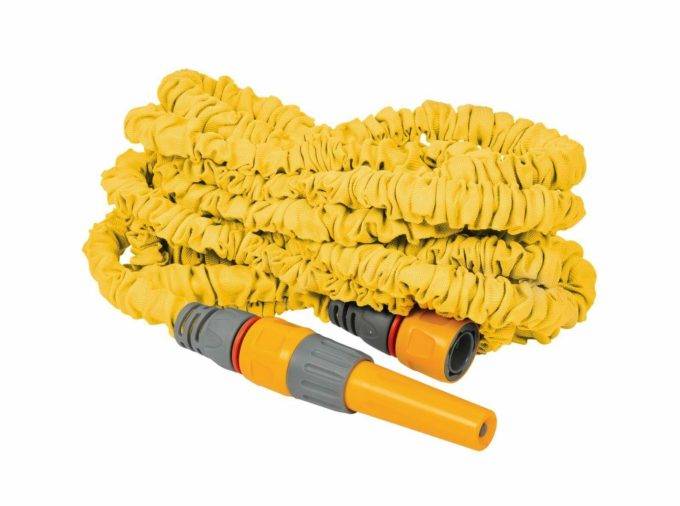
The peculiarity of such a hose is a cone-shaped nozzle that enhances the water pressure.
Disassembling and flushing the siphon
The easiest way to do this is if the siphon is plastic. It is enough to unscrew the "cup" counterclockwise, pour its contents into the toilet and rinse with warm water and detergent. In the case of metal or copper pipes, you will need the help of a qualified plumber.
Causes of odor in pipes
Sewer stench is not just an unpleasant phenomenon that requires action. This indicates the appearance of harmful microbes, fungi, mold and infection in the bathroom, which are much more difficult to clean.
In addition to pathogenic microorganisms, gas-forming elements penetrate into the room:
- ammonia;
- hydrogen sulfide;
- thioalcohols.
It is harmful to inhale such vapors. If there are children and sick people in the house, it is urgent to do cleaning, otherwise it will certainly affect the state of health.
There are several reasons for the formation of an unpleasant odor - from collected condensation to poor ventilation:
- Siphon problems (installation, corrugation stretching, no bending, clogging).
- Breakdown or breakage of the water seal.
- Sewer leak in the bathroom.
- Condensation due to poor ventilation.
- Breakage of mixers.
- Stagnation of water.
- Irregular cleaning of the toilet cistern.
- Insufficient use of sealant at the joints or drying out.
- Damage to the pipeline.
To determine how to get rid of the problem, and what kind of cleaning is required, you can consider the main sources of problems in the bathroom.
Siphon
Structurally, this element is designed in such a way that water never completely leaves it. If the technology was violated during its installation, the occurrence of condensation and odor is guaranteed in a short period of time.
If the branch pipe is too high or low in the barrel-shaped, with a throat, the evaporation device comes out above or below the water-forming plug. The odor trap is not able to fully cope with its functions.
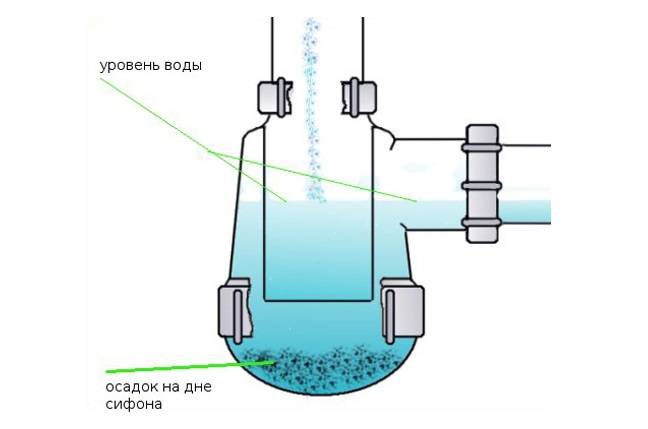
The corrugated tube of the siphon stretches and sags over time, and a pocket is formed where:
- condensate;
- skin particles;
- fat;
- hair.
Also, a problem may appear due to improper fastening, when tape is used instead of a clamp for temporary measures.
The clogging of the siphon is expressed by a specific odor.The deposited accumulated dirt begins to decompose, creating favorable conditions for the multiplication of bacterial colonies.
During evaporation, a characteristic condensate is released, which gives an unpleasant aroma.
Some models of siphons do not require dismantling for cleaning, it is enough to use a suitable tool. But in the presence of corrugated pipes, you will need to completely disassemble the system in order to get rid of the problem.
Odor trap
Building codes require strict compliance with pipe diameters. If the dimensions have not been respected, the section will overlap with drainage elements. As a result, the details in the bathroom will break off.
To maintain the pressure level in the sewer system of private houses, the fan element is brought out to the roof of the building. Due to weather conditions, the pipe is often clogged with leaves, covered with a crust of ice.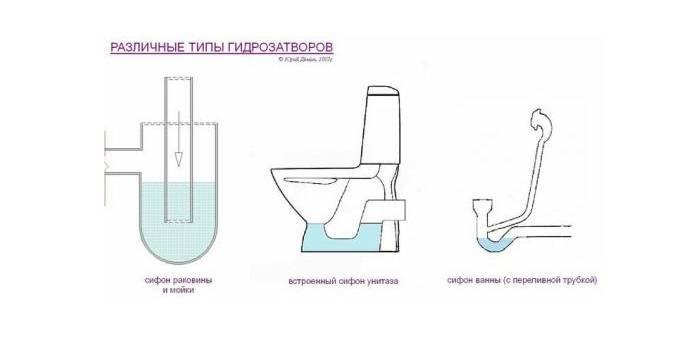
It will also be necessary to get rid of the unpleasant odor in the case of narrowing of the sewage gaps. During operation, communications are clogged with large layers of dirt and limescale.
You can fix the problem using a special tool.
Leakage
If the tightness is broken, microscopic cracks are formed. Through them, water seeps out, creating condensation. Because of this, mold and pathogenic microbes appear, which, when multiplying, give an unpleasant odor.
Pipes can become unusable, with time small holes appear on them. It is especially difficult to determine the problem if the problems are in the floor slabs.
Also, the cause of the stench is the loose fastening of the drain element with a corrugation.
Ventilation
Bathroom - a room with a constant high level of humidity
It is important to equip the room with normal air circulation.
Old multi-storey buildings use a natural system that is not able to fully provide adequate ventilation.
In addition, the canals require regular cleaning because they become clogged:
- dust particles;
- garbage;
- dirt.
Many homeowners choose to install fixtures. These can be sophisticated modern electronic devices, but it is enough to install a powerful fan in the mine, which should only work when using the bathroom.

6 Leaks - we eliminate microcracks and leaks
Pipes often leak at the joints, and an unpleasant odor spreads in the room. We eliminate leaks depending on the cause of the leak. If the nozzles are displaced, we restore the correct position. On plastic pipes, for various reasons, rubber sealing rings fail, which we change or process the joints with a sealant. On cast iron joints, we also use silicone sealant or, if they are located horizontally, cement mortar.
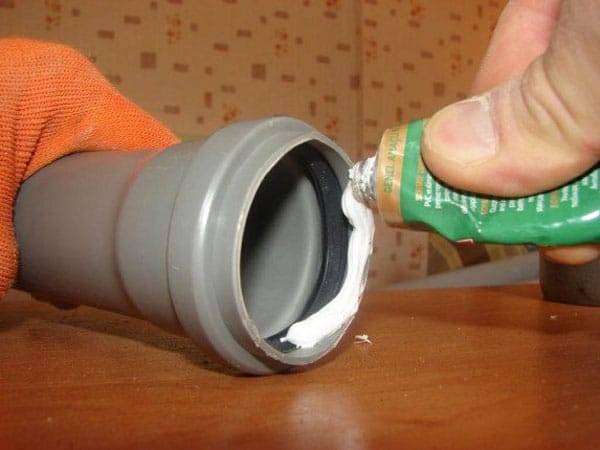
To eliminate the leak in the plastic pipe, drain the water and dry it. We prepare a patch from a pipe of the same diameter: cut off a piece of the required length, cut it lengthwise. Apply a layer of glue suitable for the given material near the place of the crack or rupture. Apply a patch and press down. If a crack is found at the junction, we apply a layer of silicone, oil paint, glue to it. Wrap with tow, bandage, and apply a water-repellent layer on top.
We fix cracks in cast iron pipes using epoxy glue or cold welding. Wrap the place around the crack with a bandage soaked in epoxy and fix it. You can also use a piece of non-thick rubber, which we wrap around the leak, fix it with wire or a clamp. The absence of high pressure will provide reliable sealing even in such simple ways.
Self-cleaning of the siphon
This "disaster" does not require the obligatory presence of a plumber, since it is possible to eliminate the smell of sewage in the bathroom, if the culprit is a siphon, without the help of a master. Cleaning is done in two ways. In the first case, disassembling it is not needed, in the second it is necessary.
Cleaning the siphon at the "accident site"
The work consists of several stages.
- A bucket is placed under the siphon, then the sump is unscrewed, in which all the garbage accumulates.
- The area with a water seal is washed under running water, thoroughly cleaned of debris, the walls are treated with a sponge and a special tool.
- The element is put back in place, screwed tightly.

More often, this relatively simple operation is enough for the smell to disappear without a trace, but in some cases the elementary method does not help. Then you cannot do without drastic measures.
Option with parsing the system
First, repeat the same steps as in the previous case.
- After the water is drained from the water seal, they are engaged in a branch pipe with which the siphon is connected to the sink (booth).
- To do this, unscrew the nut, dismantle the element. Both parts are thoroughly cleaned, then rinsed with hot water, wiped off, and put back.
If the operation was successful, all contaminants are removed, then the bad smell will disappear without a trace. And regular prevention will help you forget about such a problem forever.
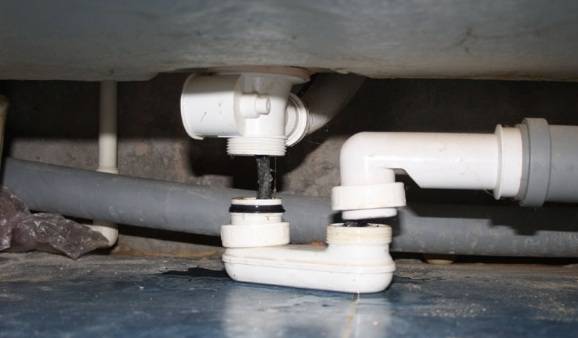
Potential Causes
Several factors can provoke such a "fragrant" nuisance.
- Incorrect design or mistakes made during the installation of the sewage system. In this case, neither household chemicals nor air fresheners will be able to cope with the problem. The only correct solution would be to rework the system, but qualified craftsmen are needed to work.
- Incorrect slope of the sewer pipes. It must be sufficient so that the wastewater does not have the opportunity to stagnate. If such conditions are created for her, then an unpleasant smell in the bathroom is guaranteed. The way out is the restructuring of the pipeline.
- High pressure in the sewerage system. It causes air bubbles to escape through the siphon. The pipes, completely clogged with drains, are to blame for this. They provoke the nuisance of blockages, icing, insufficient diameter of the channels.
- Clogged pipe. Since hair, wool, dirt particles regularly enter them, voluminous lumps form there. They become an obstacle-magnet for the next portions of dirt, gradually turning into unpleasant-smelling corks.
- Small leaks. It is easy to find a large "ocean" in the bathroom, but it is quite easy to miss a small puddle. Dirty water, regularly accumulating and evaporating, will constantly provoke the appearance of suspicious odors.
- Incorrectly functioning ventilation. If it is clogged, the result will be the same. The room will have musty air, constant dampness, and soon an unexpected guest will inevitably appear - mold.
- Rare use of the sink. In this case, the reason is elementary: it is the drying out of the water seal. The "cure" is also the simplest: filling it with water. Better to make a solution with a disinfectant.
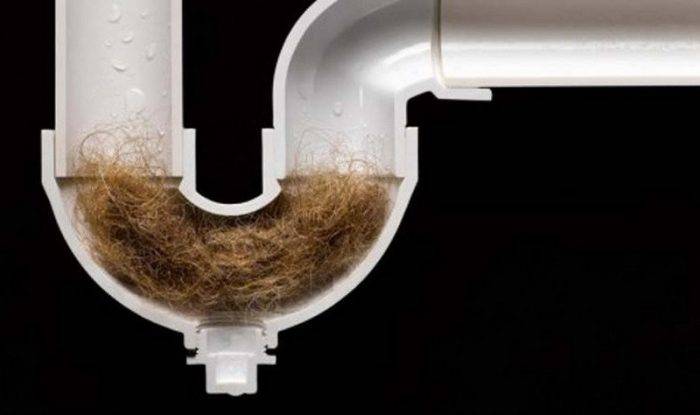
In this case, it is important to find the reason, the source of the "unforgettable amber" in time. If the bathroom is combined, then the circle of "suspects" expands
You will have to check the common riser, as well as the toilet and communications leading to it.
How to remove odor with home remedies
Home remedies are less aggressive than household chemicals. Plus, no special purchases are required to use them - salt, soda, citric acid, or vinegar can be found in every kitchen.
Such products will not cope with the blockage and will not help if the old plaque stinks. It is best to use them regularly as a preventative measure to prevent unpleasant odors in the kitchen.
Salt
The salt not only dissolves the grease, but also absorbs the sewer odor from the sink. For the remedy to work, it is necessary to pour 5-6 tablespoons of salt with a slide into the drain and pour a glass of boiling water. After 15-30 minutes, flush the drain with a large amount of water.
Soda and vinegar
It is difficult to understand how to get rid of the smell from the sink if there are both organic deposits and limescale from hard water inside it at the same time.The work is step-by-step and requires accuracy: before cleaning, you must put on gloves on your hands and protect your eyes from accidental splashes with glasses.
Pour 3-4 tablespoons of soda into the sink drain. Then you need to pour out the glass of 9% vinegar and immediately plug the drain with a stopper. The reaction between alkali and acid will loosen all deposits, and rinsing with water 15 minutes later will wash away the remnants of funds from the sink and communications.
Lemon acid
Pour a pack of citric acid into the sink drain in the kitchen and pour a glass of boiling water. Rinse with plenty of running water after 20-30 minutes. The citric acid will not only wash away organic deposits from the pipe, but will also give a pleasant lemon scent from the drain, which will last in the kitchen throughout the day.
Disadvantage of this method: if the organic waste is not completely washed off, the stink in the kitchen will be stronger, since the smell of citric acid will simply mix with the "aroma" of decay.
Dry mustard
Mustard powder is often used in the kitchen for washing dishes. It can be used to clean the sink drain. To do this, 3-4 tablespoons of powder must be poured into the drain and pour a glass of boiling water. Rinse after half an hour with plenty of running water.

The disadvantage of this method is its own strong mustard smell, which causes headaches and dizziness in some. With poor tolerance of mustard, you can not be in the kitchen during the action of the product, but it is better to refuse it altogether.
How to eliminate sewer odor using household chemicals
In the departments of household chemicals, you will find a wide variety of special products for removing blockages and odors from the sink. They help remove unpleasant odors from pipes, unclog the sewer system of any organic build-up, and disinfect the interior surface.
Similar products are available in 4 forms: gel, liquid, powder or granules. Be careful, most products contain toxic components, so carry out the procedure using personal protective equipment and thoroughly ventilate the area after processing.
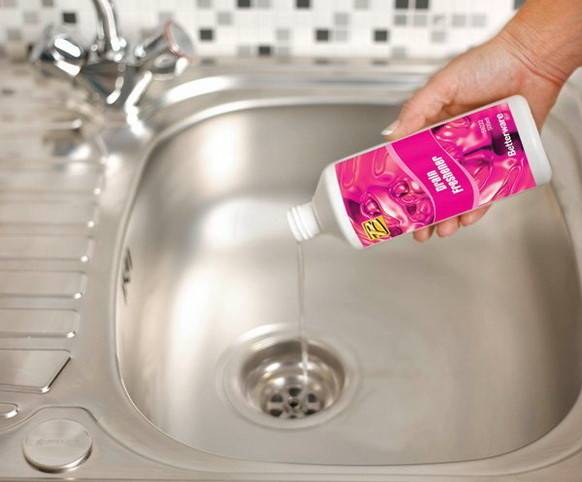
Popular store-bought pipe cleaners:
Mole. The substance has long been actively used by housewives. The product is now available in the form of a gel, liquid or powder. Dissolves hair and organics well. Of the minuses, the slow speed of exposure is usually distinguished.
Tyreth. Despite its popularity, the remedy is used mainly for preventive purposes. The more effective Tiret Turbo gel is only able to deal with minor blockages. It is forbidden to use the substance on copper and rubber parts.
Flop. It is produced in the form of granules, which begin to act in combination with hot water. A very effective agent that actively affects organics, therefore, it can harm thin plastic.
Mister Muscle. Shows its effectiveness within 2-3 hours after use. Presented in the form of granules for dilution with hot water or in gel form.
Rowdy. Effective substance that helps to remove small blockages very quickly. In more difficult situations, it is enough to simply increase the exposure time of the gel.
Pothan. Has the maximum effect. Granules under the influence of water foam strongly, boil and swell, which helps the substance to cope with even the most difficult blockages
However, in case of an overdose of the product, the pipes may break off or mechanical damage to the plastic pipes, so use Pothan strictly according to the instructions and with extreme caution.
To remove a small blockage, you can use the usual whiteness, which will also help to disinfect the sewer system inside. Unfortunately, the chlorine-containing substance cannot cope with large blockages.
We check the health of the plumbing
The very first thing to do when an unpleasant odor appears from the sink or bathroom is to disassemble and clean the siphon.Very often it is the dirt accumulated in this device that stinks, consisting of food or fat debris. Sometimes the siphon can burst from sudden changes in temperature of the drained hot and cold water. In this case, you can try to solder it with a hair dryer and a piece of plastic, or glue it with epoxy glue and fiberglass. But it is better to replace this part in order to be completely sure of its serviceability.
Often the cause of the unpleasant smell lies in a faulty siphon.
In addition to problems with the siphon, there are many other possible reasons for the appearance of unpleasant odors in the kitchen and in the bathroom, namely:
- Clogged sewer;
- Leakage of water from hydraulic locks;
- Cracks in pipes or loose joints;
- Weak fit of revisions of sewer risers.
To eliminate the causes of the malfunction, the defective place is first localized, and then it is repaired.
Clogged drain pipes
If a blockage appears in the drain line, it must be removed. To do this, you can use a plunger, having previously collected a small amount of water in the sink. For the same purpose, you can use a vacuum cleaner by installing its hose for blowing out, and then connecting it to the drain pipe. It is only necessary to pre-seal the connection point.
Strong blockages will help to eliminate the plumbing cable
To eliminate more severe blockages, a plumbing cable is used. While rotating this device, periodically turn on the water supply. This will help to quickly cope with a clogged sewer.
In the case of plastic pipes, this method should be used very carefully.
If there is no plumbing cable, then a long thin hose can correct the situation. It is pushed into the pipe, and then the hose entry point is blocked and water is released. Under the influence of the pressure of water, the blockage is gradually washed away. Additionally, it is necessary to disassemble and rinse the siphon.
Lack of water in the water seal
In order to prevent odors from the sewer from entering the house, water locks are arranged at all drain holes, in the simplest case, they are a U-shaped elbow filled with water. It is the liquid that prevents the spread of the stench. Water from the water seal can evaporate if the tap is rarely opened.
Also, the absence of liquid may indicate a breakdown of the water seal. This is what they call the suction of water into the riser. This is possible in case of malfunctions in the ventilation of the sewer system, which occur when foreign objects enter the riser, as well as when it freezes in winter. To make sure that the main sewer pipe is well ventilated, you need to go up to the roof and inspect it.
The odor trap prevents the penetration of odors from the sewer
A hissing or squelching sounds coming from the sink when water flows out indicate a breakdown of the water seal, so listen for the sounds coming from the drain hole to detect this malfunction.
Often, a water seal is arranged by installing a bend of a corrugated pipe instead of a siphon. Over time, this pipe can sag, thereby contributing to the breakdown. To avoid this phenomenon, secure the bend with wire or electrical tape.
Elimination of pipeline defects
Cracks, crevices and leaks in joints are common in old sewer systems. Various methods are used to eliminate them. Small cracks in straight sections of pipelines are repaired by applying bandages or sealing clamps. Large holes are sealed with patches and epoxy. Leaks in pipe connections are eliminated by packing from a tarred asbestos cord.
In some cases, the cause of an unpleasant odor can be a depressurization of the junction of the drain and sewer pipes. It is necessary to carefully inspect the connection point and, if necessary, eliminate the leaks with silicone sealant.
Simple ways to eliminate odor
If the cause of the problem is a blockage, the solution is simply to unclog the pipes. Various chemicals are used for this purpose. For example, "Mole", "Domestos", "Mister Muscle" and others. In order to get rid of the smell, you can also use folk methods:
- Table salt is poured into the pipeline. Then, after waiting a little, it is washed off with running water;
- Washing soda (2 tablespoons) are poured with a liter of boiling water. Then the composition is poured into the drain hole;
- Soda is poured into the drain. Acetic acid is poured in after it. The drain hole must be tightly closed. After half an hour, the drain opens, water is turned on to flush the composition;
- A mixture of washing soda and salt is being prepared. Then it is poured into the drain hole. Salt helps to get rid of the amber, and washing soda helps to clear the pipeline.
Tiret to help.
In order for the smell from pipes in the kitchen and in the bathroom not to bother you in the future, it is recommended to apply the above measures for prevention once a week. For this, you can use preventive chemicals. There are also temporary ways to remove odor from pipes:
The zest of an orange or lemon is set on fire in the room. A small piece is enough
At the same time, it is important to comply with all safety measures;
The bathroom must be ventilated after each "bath procedure". A constantly closed door only exacerbates the problem;
Until a solution is found, you can use air fresheners.
Additional recommendations
- If the structure is completely functional, the cause of the problem may be the evaporation of liquid in the water seal, caused by infrequent use of the taps;
- If you are going on a long train, add oil to the waterproofer. This way you prevent drying out in the system;
- Purchase a special siphon. It will be a kind of obstacle for amber;
- Replace the gaskets in the pipeline.
What if you have already tried many methods, but the unpleasant smell from the pipes remains? In this case, it makes no sense to buy more and more new chemicals, look for folk ways to combat amber. Most likely, the cause of the problem is more serious than you think, and you will not be able to get rid of it with the usual means. In this case, do not overuse air fresheners. It is better to try to replace the system as soon as possible if the reason lies in it, or inquire about the general condition of the sewage system in your home. In the latter case, you should contact the appropriate services for help.
The kitchen is the most frequently visited place in the house. Entering this room, you want to feel the pleasant smells of baking or the freshness of detergents, but expectations are immediately shattered by the unpleasant aroma that comes from the sink. It, mixing with the smells of delicacies, can cause even more disgust, and the stay in the kitchen becomes unbearable. In addition, the stench from the sewage system can affect the human respiratory system due to the ammonia and hydrogen sulfide contained in the composition. Questions arise: “How to get rid of the smell from the sink in the bathroom, in the kitchen? How to protect yourself from harmful substances? How to eliminate the cause of such discomfort? "
So, if there is a smell from the kitchen sink, how to fix it? The main ways to solve the problem are reduced to actions that can be performed without special knowledge, but some problems cannot be solved without a wizard. In any case, the house should have a plunger, special detergents, dry rags, plumbing strings. To begin with, if it smells from the sink in the kitchen (how to fix the problem, we will consider further), you need to find out the reason for the appearance of an unpleasant odor.
Methods for eliminating unpleasant odors
Using household chemicals
Modern industry produces a variety of chemicals designed to both unclog even the most severe blockages, and to remove the unpleasant odor coming from the drain hole.Such preparations are both liquid and gel-like, and even in the form of granules.
Chemicals used to remove blockages and unpleasant odors in drain pipes
Good results are obtained by using the compositions "Krot", "Deboshir", "Odorgon", as well as "Domestos", "San Clean", "Tiret" and others. These funds are poured into the drain and kept for a certain time (usually 2-4 hours), which is indicated on the package. Then the drain is rinsed with plenty of warm water.
If the drain in your apartment is made of plastic pipes, use the Israeli Pothan remedy. These granules are not only suitable for metal pipelines, but also do not destroy plastic products.
Good results can be obtained by using household chemicals that contain chlorine. For example, you can use "Whiteness" or dry bleach powder. The use of such substances will also save your finances. Even more savings can be achieved by knowing one secret. Namely, all of the above drugs are based on the action of soda ash, so you should always have a package of this substance on hand.
Folk methods
If you don't have special chemicals on hand to clean your drain, don't be discouraged. The compositions discussed below can be prepared in any kitchen.
To eliminate the smell from the sink, stir three tablespoons of regular baking soda in 1 liter of warm water. Then this solution is poured into the drain hole and kept for at least 30 minutes. After that, the drain is washed with hot water. You can use table salt instead of baking soda.
When flushing the drain with hot water, consider the material of the sewer pipes. In the case of using plastic products, you can damage the line with boiling water.
Table vinegar or acetic acid solution is used in the same way. At least 0.5 l of liquid is poured into the drain and wait 20-30 minutes. Then the pipeline is flushed with warm water.
Simple drain cleaners can be found in every kitchen
Often, both baking soda and vinegar in a 1: 1 ratio are used to remove an unpleasant odor. First, baking soda is poured into the hole, and then vinegar is poured.
A good effect is also given by dry mustard powder, which is poured into the drain, and then poured with boiling water. However, this method is not suitable for plastic pipes.
Do not be ironic about folk methods. The fact is that any unpleasant smell from the sewer is the result of the activity of bacterial colonies. With the elimination of these bacteria, the stench goes away. You can fight them with any alkalis or acids, even if they are ordinary soda and vinegar. Plus, by using these substances instead of "real" chemistry, you are saving the environment.
Prevention of blockages - the guarantee of the absence of unpleasant odors
Why the sewer smell is dangerous
Air from the sewer, entering an apartment or house, in addition to the disgusting smell, has a negative effect on the health of people who inhale it. It is not for nothing that a person feels an aversion to certain aromas; this happens in cases where substances emitting these odors can be harmful.

In this case, these are substances such as hydrogen sulfide, ammonia and methane. The most strong-smelling of them are ammonia and hydrogen sulfide, methane has no smell at all, but this does not make it less harmful. If you breathe in these gases constantly, the consequences will not be long in coming. The respiratory and nervous systems are primarily affected. A feeling of anxiety, a nervous breakdown, or, in rare cases, fainting may occur for no reason.
Reasons for the smell of sewage in the bathroom

Not always the cause of the appearance of an unpleasant odor in the bathroom is a dumped wet rag. Some owners try to mask the stench with the scent of a freshener. But this method gives only a short-term result. If you don't find the source of the bad smell and fix it, the problem will only worsen.When the stench comes from sewer pipes, there are several explanations.
Poor ventilation
At high humidity and high temperatures, which are often in the bathroom, the circulation of air masses is disrupted. In this case, the hood helps. An unpleasant aroma leaves through it, the air becomes drier after moisture and condensation are removed. If the standard exhaust system in the apartment does not work well enough, it is supplemented with forced ventilation.
If the air does not circulate, fungus will settle on the walls in conditions of high humidity. Indoor air becomes heavy. An unpleasant aroma in such conditions is almost impossible to mask with a freshener.
Clogged sewer
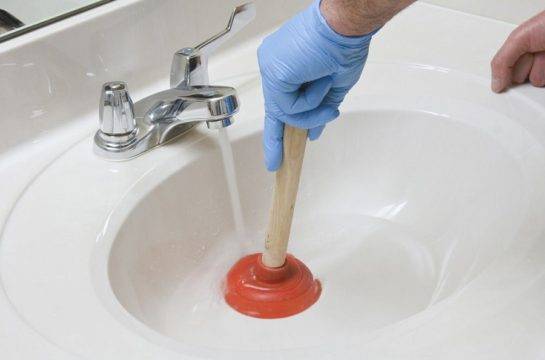 Due to a blockage or damage to the sewer pipes, an unpleasant odor spreads to the neighboring apartments. Dirt accumulated in the sewer settles on the inner walls and decomposes. This gives off an unpleasant odor during the evaporation of the condensate.
Due to a blockage or damage to the sewer pipes, an unpleasant odor spreads to the neighboring apartments. Dirt accumulated in the sewer settles on the inner walls and decomposes. This gives off an unpleasant odor during the evaporation of the condensate.
Important!
If the pipes are not cleaned in a timely manner, a plaque forms inside and an environment favorable for the reproduction of pathogens in the form of mold arises.
Leaks and condensation
Small bathrooms have a lot of pipes, plumbing fixtures, and household appliances. In such a tight space, it is difficult to detect leaks or condensation in time. Gradually accumulating water begins to destroy building materials, rotting occurs. The smell from this process penetrates into other rooms and apartments of neighbors.
Incorrect installation
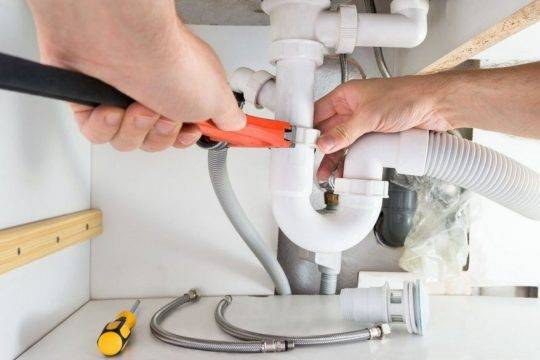
Often sewer stench appears due to malfunctioning of the siphon. It often comes from the sink drain and occurs for the following reasons:
- If the siphon is incorrectly installed, the corrugated pipe connecting the sink to the sewer system does not have a bend and is above the liquid level. Because of this, air from the chimney enters the apartment.
- The corrugated part of the pipe is severely stretched.
- When the sink is not used for a long time, the liquid accumulated in the siphon dries up. From this, extraneous aromas gain access to the room.
- The siphon is clogged with foreign objects.
- The pipe is not completely submerged in water. Then between the inner surface of the siphon and the water there is a space through which foreign aromas penetrate.
- Due to the short partition of the siphon, the water seal constantly breaks down and lets the sewer aroma into the apartment.
- Extension of the corrugated pipe.
- Installation of the siphon in the wrong position.
Usually, these are the reasons why stinks are the most common. Moreover, pollution sometimes occurs even after a short-term use of the sewage system. In this case, the problem may be hidden in the small diameter of the riser. If it is less than 11 cm in diameter, then the passage of drains is difficult, a blockage forms, which is the cause of the stench.
Poor sealing of joints
Violation of the sealing of the connections in the sewer system leads to leaks and air penetration from the pipe into the apartment. If the parts are threaded, they are tightened to ensure a tighter fit to each other. Otherwise, the joints are reinforced with a sealant or putty. You can buy such a tool at a hardware store. Such methods will help get rid of the unpleasant odor for a while. But for reliability, it is better to replace the pipe.

